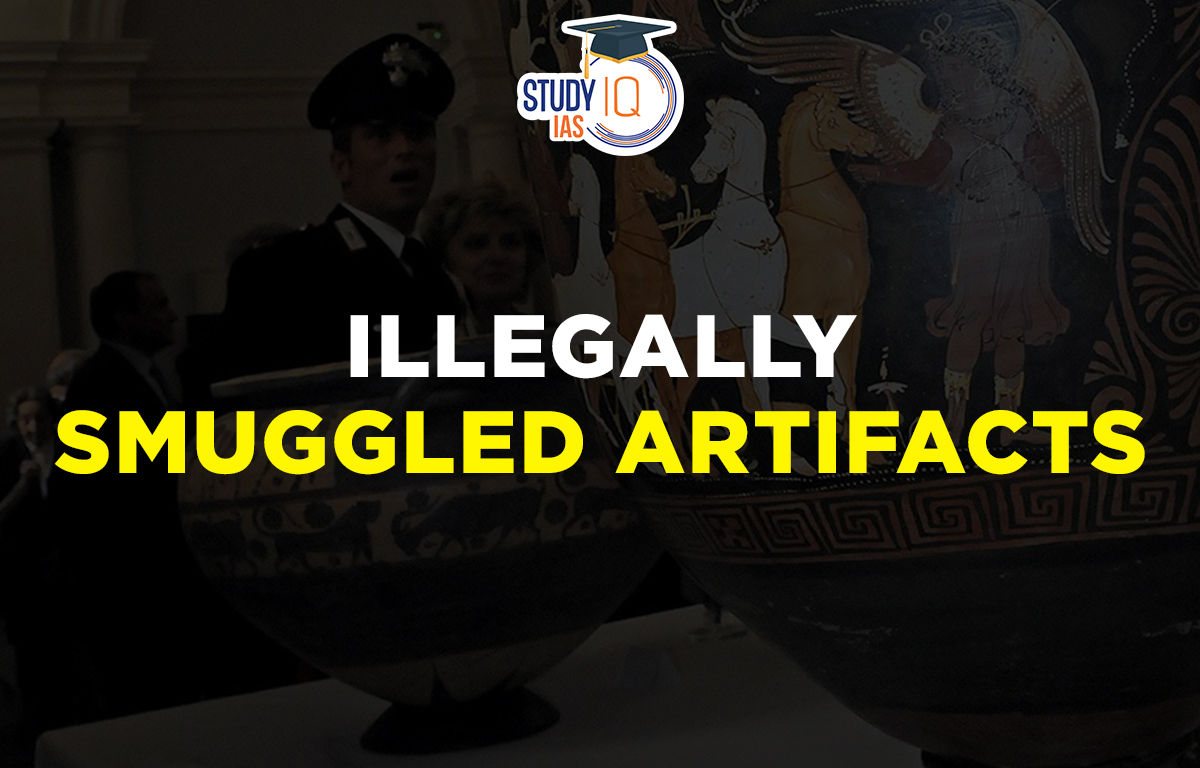Table of Contents
Context: Recent Investigations have found that the Metropolitan Museum of Art in New York has at least 77 items in its collection that are of Indian Origin.
Some Prominent Sculpture and Painting
| Artefacts | Culture |
| Moon God Chandra in His Chariot with Wife and Attendant | India (West Bengal).
Date: 2nd–1st century BCE (Shunga period, a dynasty which ruled Magadh during 185 to 73 BCE).
|
| Kamadeva, the God of Love |
|
| God Revanta Returning from a Hunt | India (Karnataka or Andhra Pradesh).
Date: ca. 10th century; “later Chalukyan period.”
|
| Yakshi Holding a Crowned Child | India (Bengal)
Date: ca. 1st century BCE; (Shunga period).
|
| Rattle in the Form of a Crouching Yaksha (Male Nature Spirit) | India (West Bengal, Chandraketugarh)
Date: 1st century BCE; (Shunga period).
|
| Parikara (Backplate) | India (Gujarat)
Date: dated 1449; “The reverse of this back plate has a lengthy inscription with a date of 1507, corresponding to A.D. 1449”.
|
| Panel with Krishna and Gopis | India (Orissa)
Date: 17th century
|
| Head of a Male Deity | India (Jammu & Kashmir, ancient kingdom of Kashmir, Harwan)
Date: 3rd–4th century.
|
| Goddess Durga Killing the Buffalo Demon, Mahisha (Mahishasura Mardini) | India (Rajasthan, Mewar)
Date: ca. 1760; “Finished paintings of this subject are well known from the Mewar court and neighboring ateliers”.
|
| A Swooning Lady | India (Rajasthan)
Date: late 19th century; made of “Ink, transparent, and translucent watercolour on paper”.
|
| Woman with a Turban Dressed as Radha | India (Rajasthan, Kishangarh)
Date: late 19th century; “This woman of the Kishangarh court is dressed as Radha, Krishna’s lover. The elongated head and stylized eye are typical of a figural type that emerged in the Kishangarh court in the late eighteenth century”.
|
Heritage Laws in India
- In India, Item-67 of the Union List, Item-12 of the State List, and Item-40 of the Concurrent List of the Constitution deal with the country’s heritage.
About Antiquities
- In India, Antiquities and Art Treasures Act (AATA), 1972, defines “antiquity” as
- Any coin, sculpture, painting, epigraph or other work of art or craftsmanship;
- Any article, object or thing detached from a building or cave;
- Any article, object or thing illustrative of science, art, crafts, literature, religion, customs, morals or politics in bygone ages;
- Any article, object or thing of historical interest that has been in existence for not less than one hundred years.
- For manuscript, record or other document which is of scientific, historical, literary or aesthetic value this duration is “not less than seventy-five years.”
- Provenance’ of an antiquity: Provenance includes the list of all owners from the time the object left its maker’s possession to the time it was acquired by the current owner.
- Check for fake antiquities: Under section 14(3) of the AATA, every person who owns, controls or is in possession of any antiquity shall register such antiquity before the registering officer and obtain a certificate in token of such registration.
- National Mission on Monuments and Antiquities, 2007: It has registered 3.52 lakh antiquities among the 16.70 lakh it has documented, to help in “effective check” of illegal activities.
- However, according to Ministry of Culture, total number of antiquities in the country is around 58 lakhs.
Way of bringing back Antiquities to India
- There are three categories
- Antiquities taken out of India pre-independence.
- Antiquities taken out since independence until March 1976, i.e. before the implementation of AATA.
- Antiquities taken out of the country since implementation of AATA, 1976.
- For items in the first two categories, requests have to be raised bilaterally or on international fora.
- Antiquities in the third categories can be retrieved easily by raising an issue bilaterally with proof of ownership and with the help of the UNESCO convention.
International Effort to Safeguard Antiquities
- UNESCO 1970 Convention on the Means of Prohibiting and Preventing the Illicit Import, Export and Transfer of Ownership of Cultural Property
- It defined “cultural property” as the property designated by countries having “importance for archaeology, prehistory, history, literature, art or science.”
- According to Convention, Illicit import, export and transfer of ownership of cultural property is one of the main causes of the impoverishment of the cultural heritage of the countries of origin of such property and that international co-operation constitutes one of the most efficient means of protecting each country’s cultural property.
- An INTERPOL report in 2019 said that almost 50 years after the UNESCO convention, the illicit international traffic of cultural items and related offences is sadly increasingly prolific.













 Daily Quiz 17 April 2025
Daily Quiz 17 April 2025
 Nilgiri Biosphere Reserve, Map, Climate,...
Nilgiri Biosphere Reserve, Map, Climate,...
 Complete List of Indian State Animals
Complete List of Indian State Animals





















